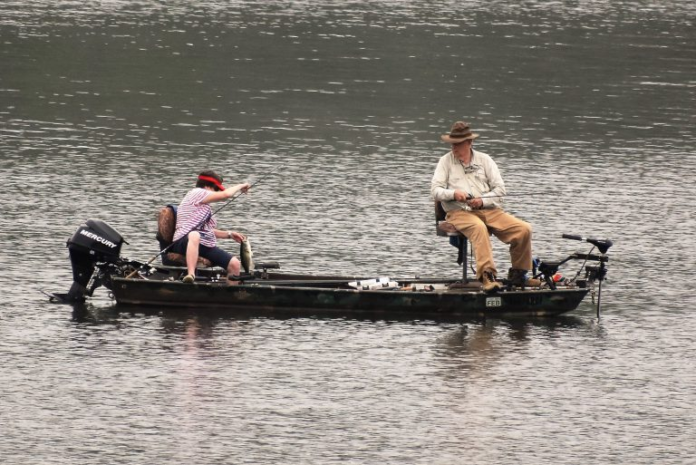
CULLMAN, Ala. – In July 2018, as officials awaited pending litigation over the Duck River Dam, the City of Cullman went forward with plans to open the 640-acre Duck River Reservoir to boats and fishers, and to open the entire 22 miles of interconnected bicycle and hiking trails that encircle the lake.
Cullman Economic Development Agency (CEDA) Director Dale Greer told the crowd assembled for the ribbon cutting that day, “Today we celebrate the aspects that have been created other than the drinking water supply. Having the drinking water supply was really, really important, but if you didn’t do something with the recreation potential on this reservoir, that really, really would’ve been a shame. It was part of the Corps of Engineers plan that we had to do that, but what we have prepared and done as a community is much beyond what was required of us, and I really, really am proud of what’s here.”
The lake contains (naturally or by stocking) the following fish species:
–Florida and Alabama Bass
–Bluegill and Redear Bream
–Black Crappie
–Channel Catfish
Greer also spoke about the reservoir trail system, saying, “The trails are really a special feature, managed by the Cullman City Parks and Recreation department, Nathan Anderson and his team. They took on a huge responsibility with 20 miles of trail. You just imagine the maintenance and upkeep on that, around that scenic reservoir. But it is going to be special. I think it will generate a lot of traffic here, and really will be meaningful for us.”
Recreation on the lake/reservoir
According to a 2013 plan prepared for the Utilities Board by St. John & Associates, “The landscape surrounding the proposed Duck River Reservoir is comprised of rolling hills that are deeply incised by streams with exposed sandstone cliffs. Land above the reservoir is largely farmland and forest with moderate to steep slopes in the range of 20% to 30% near the full pool water elevation. Acquired property downstream of the proposed dam features steep, deeply shadowed cliffs and a broad bend in the river surrounding mixed forest and meadow land cover. This rich physical geography and varied landscape result in a scenic setting for the proposed Recreation Area and many potential uses that do not conflict with the overall water supply purpose of the reservoir. Recreation use of the property is proposed to be focused at three primary areas linked by a multiuse pedestrian and bike trail.”
Also from the plan, the areas are:
- Downriver Use Area – “Natural river and canyon landscape downstream of Duck River dam. Uses include environmental education, wheelchair accessible pedestrian access, wildlife observation, outdoor recreation and hiking.”
- Henderson Branch Landing – “Existing cleared meadow and abandoned road bed North of Henderson Branch and adjacent to proposed Duck River Reservoir. Uses include boating, wheelchair accessible pedestrian access and shore fishing, primitive camping, and hiking.” This area will be the primary access point for visitors with boats and other allowed watercraft, with parking provided for cars and boat trailers. According to the plan, “The proposed boat launch features concrete construction and an ADA-compliant courtesy pier for boarding. A wheelchair accessible paved trail meeting ADA standards will lead from handicapped parking to a pedestrian crossing of the reservoir at County Road 1651. This pedestrian crossing will be sized to allow wheelchair accessible fishing while providing room for users of the multi-use trail to cross the reservoir.”
- North Boat Launch – Located at the western terminus of County Road 1651 at the reservoir. “This area is expected to be a secondary access point for boaters due to the limited area available for parking and longer travel distance from US HWY 278.”
Award-winning recreational trail
The 2013 St. John & Associates plan also described the multi-use trail:
“A pedestrian and bike trail is proposed to encircle the reservoir and link the recreation use areas. Trail construction would utilize native materials exclusively and follow sustainable International Mountain Bicycling Association and Appalachian Trail Conservancy guidelines that minimize erosion and required trail maintenance. The trail would be constructed so that clearing of trees will be minimized, and no powered vehicle or equine use of the trails will be permitted. Two prefabricated pedestrian footbridges are proposed to be installed along the trail: one crossing the reservoir at the northern extent of the trail near County Road 1669 and the second crossing Duck River within the Downriver Use Area.”
Due to concerns about pedestrian traffic crossing County Road 1669 in a blind curve, the City and County together constructed a pedestrian underpass below the County Road 1669 Duck River Bridge.
In November 2017, Gov. Kay Ivey awarded the Cullman City Utilities Board $193,092 from a U.S. Department of Transportation fund to construct three trailheads along the 21-mile-long trail at Duck River Reservoir.
Speaking of the grants to Cullman and 17 other sites around the state, Ivey said, “Outdoor trails lead to healthier minds and bodies, and they are a great investment in our state and communities. I welcome these new or improved trails, and I encourage everyone to visit one and experience the outdoors that Alabama offers.”
In 2019, the trail, named the Tim Scott Recreational Trail for Duck River Reservoir Manager Tim Scott, won a national award from the Coalition for Recreational Trails “in recognition of outstanding use of Recreational Trails Program (RTP) funds,” according to the awards page on the organization’s website, which contained this description of the trail:
The Tim Scott Trail is a single track, natural surface, multi-use trail that circles the newly constructed Duck River Reservoir in Cullman County, Alabama. Preservation of the natural beauty within the buffer zone surrounding this waterbody for the enjoyment of the community was a priority for those involved with the reservoir’s construction. With the assistance of funding from our nation’s Recreational Trails Program (RTP), the City of Cullman committed to provide access to the public with construction of the trail system, boat launches, a fishing pier and multiple trailhead parking areas.
The recreational area’s development has required a collaborative involvement by Cullman County, the City of Cullman, and the Cullman Utilities Board. The Utilities Board is the owner of the reservoir and its surrounding buffer zone which provided the site for the recreational area. However, the City and County have both individually filed as applicants for the RTP funding assistance on projects associated with the trail construction and pedestrian bridge construction. As noted previously, the City also provides management and maintenance of the trail system through their Parks and Recreation department.
The project was conceived as part of the development of a 600-acre water supply reservoir to serve Cullman County. With the primary objective to protect and ensure water quality, the reservoir’s permit required the preservation of an undeveloped buffer zone around its perimeter. This area of old growth forest, rolling terrain, and rocky streams has a minimum width of 100 feet from the lake’s full pool elevation. The guaranteed protection of this corridor through north Alabama wilderness alongside the shimmering lake provided an unmatched opportunity for construction of a low impact pedestrian and biking trail.
In an effort to jump start the trail’s construction, Cullman commenced with the first phase of the trail while completing the application for funding assistance from the RTP. This phase included 8.8 miles of single-track, natural surface trails constructed by the International Mountain Bike Association under contract with the Cullman Utilities Board. The design focused on creating access to the natural beauty of the area for all users. The comprehensive plan included multiple trail access points with ample parking for trail and reservoir recreational users.
With RTP assistance, three additional construction contracts were awarded for completion of the remaining 13 miles of trail surrounding the lake along with two pedestrian bridges over the Duck River. The upper bridge spans across the river at its discharge into the reservoir while the lower crosses the tailwater beneath the dam. Funding from the RTP amounted to approximately 40 percent of these projects’ construction costs.
The trail enjoys diverse usage by trail runners, bikers, and walkers. The reservoir’s recreational area, which includes boat ramp access and fishing piers, also caters to paddlers and fishermen. Additional RTP funding has been awarded for the construction of restroom facilities at the recreational area’s three trailheads.
St. John & Associates’ 2013 plan included provisions for picnic pavilions, primitive camping sites and interpretive signage along trails. According to Cullman Utilities Board Manager Mike Manning, these were possible future developments.
According to the plan, the reservoir and its boundaries would be able to support the following recreational activities:
- Boating
- Fishing
- Picnicking
- Hiking
- Sightseeing and photography
- Nature observation
During a press briefing on the 2017 lawsuit, Greer stated that the reservoir was required to undergo a year of water quality monitoring by the Alabama Department of Environmental Management. According to information provided by CEDA Project Coordinator Susan Eller, the one-year monitoring schedule is not arbitrary, but an amount of time required by federal environmental protection regulations. Under EPA regulations, the Duck River Basin is currently classified as a “fish and wildlife” waterway. Before water can be sent to the treatment plant, the basin must be reclassified as a drinking water source termed a “public water source.” A public water source can still support a fish population and can be used for certain recreational purposes, but meets quality standards needed to begin the treatment process for drinking water. Efforts by the Utilities Board improved the water quality of the basin, and prepared it for reclassification as soon as the required monitoring period concluded.
CEDA officials reflect on project development
Monday, The Tribune sat down with Greer and Eller to talk about the development of the dam, reservoir and pipeline.
Greer told The Tribune, “I think it is remarkable, the position that this community is now, from a water standpoint. There are places all over the country that are having water shortages- I mean significant water shortages- and I think water and sewer is going to control your growth, determine whether you’re able to grow or not. This community now has their own water supply that they control for a hundred years- projected to be that future for them.”
Greer credited cooperation between multiple agencies with the success of the project, saying, “We were able to keep city, county governments, the legislative delegation, all of the water systems on board for all of that period of time. And if you think, that was four mayors, don’t even know how many commissioners, commission chairmen and those kinds of things, changes in the Utilities Board. But you could keep all of those together.
Much of the early development of the reservoir and dam was made possible by a $5 million Appalachian Regional Commission grant received by the Utilities Board in 1992.
According to Greer, “That grant made it possible for us- and by ‘us’ I mean this community and all the people and all those things- that you could continue to work the project because you had money. Most people, when they were in that situation, then they would say, ‘Well, it would cost X if we had to do this.’ Somebody was having to budget that money and do it again. Well, we had that money that we could draw down for years, and it took us a long time to go through five million. But whenever something would come up and the Corps of Engineers or EPA or whoever was in authority would say, ‘Well, y’all need to do X before you can move forward,’ we had the ability to pay for moving forward when most people would not. I think without that grant, it would have been highly unlikely that you could have kept the project going as long as it continued. We were in a very remarkable situation from the standpoint of it was a not-for-profit system.”
According to Greer, many people opposed the plan based on the notion that too high a cost would have to be passed along to customers, but said the system was never intended to make a profit beyond covering operating costs.
Keeping it local
Greer continued, “Another thing that I think helped us was that all of that drainage basin, with the exception of a little bitty tiny piece, was in Cullman County, that we controlled what was around. All of the people who were out there, that we were getting the property from, lived around the lake- those kinds of things- drank the water out of it. So that was a plus; you weren’t going somewhere in Morgan County and saying, ‘We want to build a dam and reservoir up here.’ We serve all the Cullman people; they had no interest in taking care of it, protecting it, wanting it; you know, doing anything associated with it.”
What happened to Smith Lake?
Smith Lake was a strong contender to be Cullman’s new water source, and many people- including Greer- felt like it was the answer.
Said Greer, “When they came to me with Smith Lake and said, ‘Smith Lake is an option,’ and its 500 miles of shoreline and millions of gallons of water and all of that stuff, I went to the board and said, ‘How the hell can it not be Smith Lake?’ And I said, ‘I don’t know what the answer is, but I don’t see how it cannot be Smith.’”
When studies on Smith Lake got underway, though, according to Greer, the Army Corps of Engineers found that water from Smith Lake, that is more than 200 feet lower in elevation than Cullman and Duck River, would have to be pumped uphill at a substantially higher cost than using a source already at the city’s elevation.
The Cullman County Commission, for a time, considered building its own water system drawing from the lake to a treatment plant that would be owned by the County, but the cost of connecting that system to other County-served areas not geographically connected to the Smith Lake area (including Holly Pond, Eva, Addison and three disconnected areas south of Berlin) was prohibitive.
“If they built down here at Smith Lake, they lost two-thirds of their customers,” said Greer.
On top of that, water drawn from Smith Lake would have been done at rates set by Alabama Power, which manages the lake. According to Greer, customers’ rates could have changed each year to whatever amount the power company assigned.
Additionally, according to Eller, “We were building it for a backup system, too, and they actually had in a letter that if there was a drought, they could cut us off. So there went your backup system.”
Greer said, “It never mattered to us what the answer was, because you weren’t benefiting one way or the other, depending on what your choice was or how you decided to do anything. It was just supplying the water, and whatever came up with the best economics was what was our opinion of what we say.”
Ultimately, the choice of Duck River was based on a recommendation from the Army Corps of Engineers.
Dual water sources mean cleaner water, and possibly cheaper
The Cullman Water Treatment Plant draws from both Lake Catoma and the Duck River Reservoir, and plant operators can choose which one to use or can blend water from the two.
Greer explained, “The beauty of having both of those is you use whichever reservoir has the best quality of water (at a given point in time), which means the lowest cost of production.”
Credit where credit is due
Greer has more than 25 years of his life invested in the Duck River project, Eller more than 20. Along the way, they noted, a number of others have come along to move the project forward.
Said Greer, “There were a few people who were really, really critical in all of this process, I think.”
Motioning to Eller, he noted, “I think the role she played was really good at the time. She ended up doing all of the real estate work, working with all of them on that. Susan was very important.”
Greer continued, “Tim Scott was a guy who came on board, and Tim became the reservoir manager. He was with Soil and Water Conservation Service; he’s a farmer, so he was able to talk to all of those land owners out there and quell all of the concerns and the misinformation that they got, that there’d never be any farming in the drainage basin and the intent was to get rid of all that. He was really helpful in supporting that area, could talk to those people and understood farming, and he could address their concerns. Tim is still there today, so he kind of monitors water quality, and he’s out there every day, seeing what’s going on, making sure the fishermen comply, the trail people comply, those kinds of things.”
Greer and Eller talked about how the project, which started under the jurisdiction of the Nashville office of the Army Corps of Engineers because of its location in north Alabama, had to be shifted to the Mobile Corps office because the Duck River drainage basin ultimately feeds into the Black Warrior system whose water ultimately ends up in the Mobile District. Regional Corps offices are not historically known for their cooperative efforts, but such was a necessity in this case.
Said Eller, “It was the first time they’d ever done this, and they actually used this project- the Nashville Corps and the Mobile Corps went out to Washington State and did a presentation on this project, because they had never had two districts working together before.”
When an issue arose with the Corps, Birmingham attorney Bill Satterfield, who was working on the legal end of the project, just happened to have extensive experience with the Pentagon. He was able to call Washington D.C. and schedule an appointment to meet directly with the secretary of the Army. Local Corps officials did not believe the meeting was really happening and reportedly laughed at Greer’s notification, until they received an official notification of their own.
Greer also praised Steve Newton of the CH2M Hill firm for taking on the studies and other engineering tasks for the reservoir project when changes in the Corps of Engineers caused that government agency to step away from the project. Contacting his firm during a meeting between the City and the Corps, he was able to getting backing from the firm and an agreement from the Mobile Corps office to turn over all engineering study records to CH2M Hill.
Said Greer, “I think that particular day that he saved it.”
In reflecting on the project as a whole, Greer added, “I think there were a half a dozen times that one or two people kept that ball in the air when it had the potential to just be over with, after all of the stuff that was done.”
Eller also noted the contributions of Jackie Satterfield, Steve Griffith, Kenneth Neal, Darrell Hicks and Billy Meeks to the project.
Eller added, “We were fortunate in that we always seemed to have the right person at the right time.”
Eller also took a moment to praise Greer’s 25-plus year efforts, saying, “Dale’s been here a long time, and he doesn’t take enough credit, but he kept this project on course, even though we had the obstacles the whole time. He was always pushing and pushing, because it was the right thing to do when you look at what it’s going to get us. (Water shortage) can cause you to not have industrial growth, it can cause you to not have home growth, and now we have those things guaranteed for our community for so many years.”
Highs and lows
Greer shared, “It was so many highs and lows during the course of the thing. There were days that I thought, ‘Man, this is done and it’s time to go sit down and celebrate,’ and then there were days I thought that it would never be done, that is was a new hurdle that you couldn’t get over. I’d say it’s remarkable that it stayed together, that everything was done, and so many different people played a part at the right time.”
Read part 1 at www.cullmantribune.com/2020/07/21/duck-river-reservoir-looking-back-at-the-project-part-1.
Copyright 2020 Humble Roots, LLC. All Rights Reserved.



























